Welcome to a detailed tactical analysis of Thomas Frank and his managerial tenure at Brentford Football Club. In this examination, we delve into the tactics and strategies that have shaped Brentford’s playing style under Frank’s guidance. Known for his innovative approach and commitment to expansive football, Frank has transformed Brentford into a formidable side in the English football landscape. From tactical formations to pressing strategies, we dissect the key components of Frank’s philosophy, offering insights into how his methods have propelled Brentford’s success on the pitch.
Build-up
Thomas Frank sets his team up in a 1-3-2-5 formation in the build-up, with a back-three, two holding midfielders, and five up front.

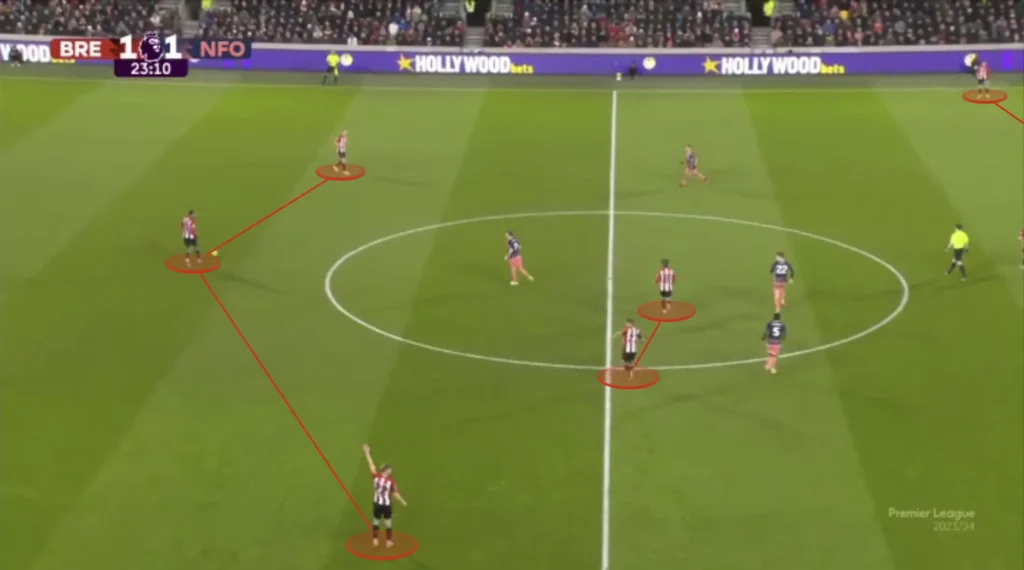
Having four central midfielders(two holding and two attacking) creates more options in the center and less space between the players. Frank likes this because he prioritizes playing through the middle. He needs one player high and wide to pull apart the backline while the rest create numerical advantages in the midfield areas. This builds good conditions in defensive transitions, allowing more players to press when they lose the ball. Another purpose for keeping many players in the middle is to shorten the distance between them. This shortens the length of the passes, which naturally shortens the time between passes. This means the opposition players will have less time to push up and press, giving the Brentford players more time and control.
Goal-kicks
From the goal-kicks, Brentford usually go long. The players set up in a 1-3-1-4-2 formation close to the halfway line, with the goalkeeper looking to find one of the strikers with a long ball. The other striker will make the run in behind while the midfielders will be ready for the second ball.


Changing Formation
Brentford often rotates in their build-up, finding new formations to confuse opponents. They also adapt to their opponent’s formation to create numerical advantages in different areas, allowing them to beat the defense and score more goals. Their most frequent formation change is to rotate the midfield to create a 1-3-5-2 formation. They may sometimes also be set up in a 1-4-3-3 formation. Their principles and general guidelines stay the same when they do this.
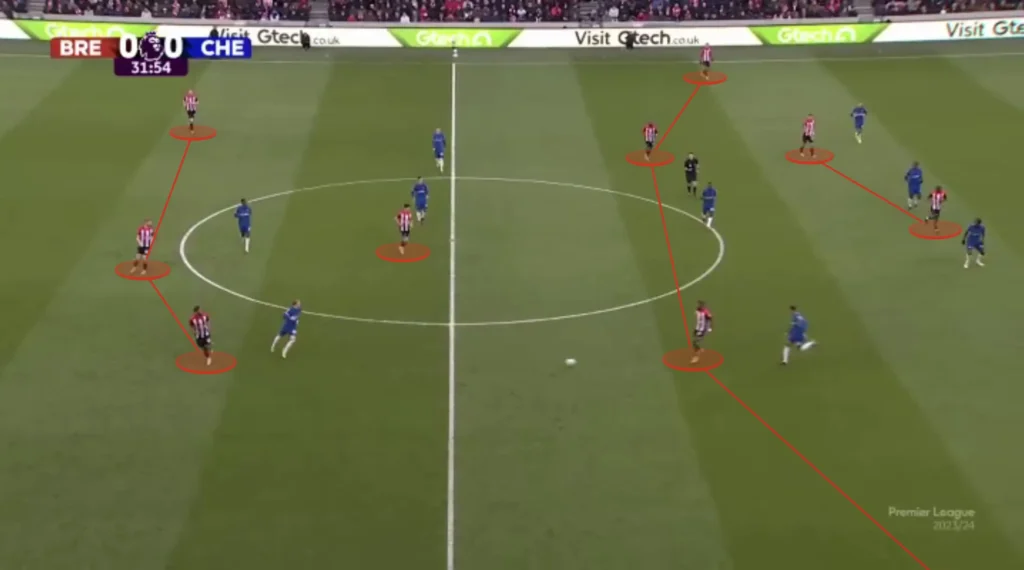
High Backline
A massive aspect of Brentford’s high build-up is they keep a high backline. This helps in the counterpress because they get closer to the center. Having more players close to the center who can win the ball back makes it difficult for the opposition to recycle possession. Furthermore, the high backline shortens the distance between players, shortening the time and length of the passes and preventing the opposition from pushing up their defense.

Numerical Advantages
Another massive aspect of Brentford’s high build-up is their ability to create numerical advantages against the opposition’s defensive line. Their front five naturally becomes numerically superior against a back four, which they are great at taking advantage of.

When the defending team is positioned on one side, the weak-side fullback becomes vulnerable to the long switch of play due to the 1v2 against Brentford’s wide player and attacking midfielder. Frank’s team often capitalizes on this by getting the ball to the wide player and creating many opportunities from 2v1 situations on the wing and in the half-spaces.

Final Third
Attacking the Half-Space
Brentford is a good team in the final third. They create many chances, mainly by attacking the space between the opposition center-back and fullback. They primarily do this from the wide areas with underlaps from midfielders or sometimes the wide center-backs.


Many Players in the Box
The attacking midfielders and wingbacks always look to make runs into the box when the ball is in the final third, often getting four or five players into these areas to create overloads. The numerical advantages in the box force the defending team to make decisions and leave some players open.
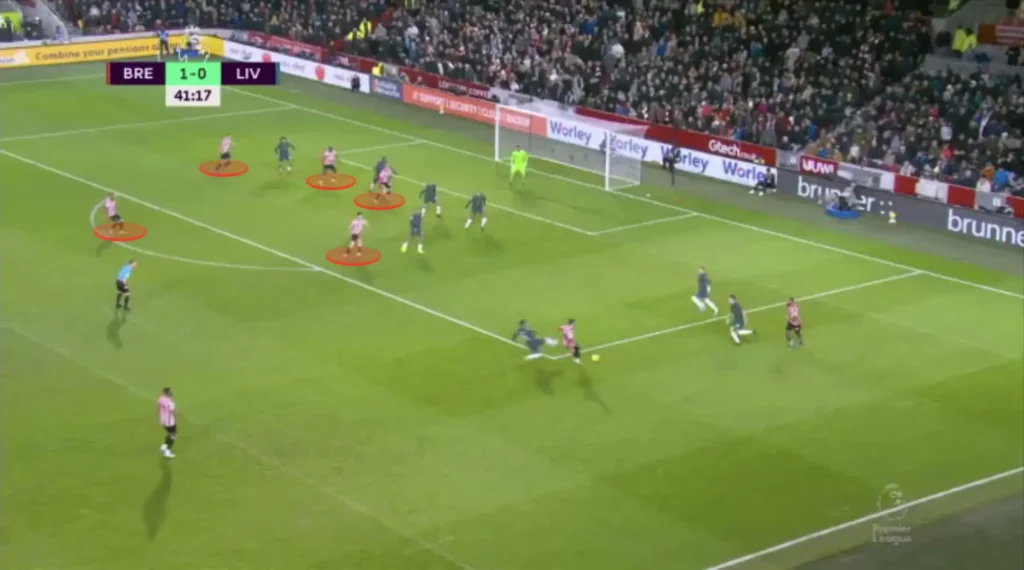
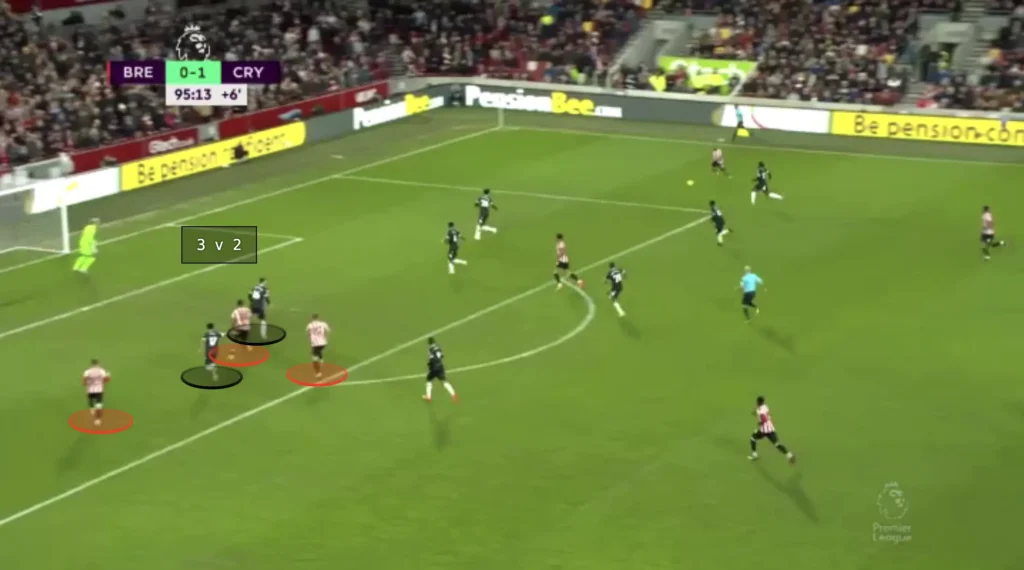
Brentford score many of their goals from crosses to the wingback at the back post. The opposition fullback will often be preoccupied with a Brentford attacking midfielder, which leaves massive space at the back post for the wingback to attack.

Thomas Frank also positions many Brentford players outside the box, ready for the second balls and cut-backs. They often succeed in pushing down the opposition’s defense, which opens the space in front of the backline. Brentford will find their midfielders in these spaces, who can shoot or combine with an attacker to create goalscoring opportunities.


Set Pieces
Thomas Frank’s Brentford has distinguished itself as a potent attacking force, particularly excelling in converting set-piece opportunities into goals. Under Frank’s guidance, Brentford has developed a strategic approach to set pieces, leveraging meticulous planning and execution to capitalize on these situations. With an emphasis on tactically intelligent movement in the box, Brentford consistently poses a threat from corners, free-kicks, and throw-ins. Frank’s meticulous attention to detail, coupled with detailed training routines, has enabled Brentford to maximize scoring opportunities from set pieces, making them one of the best teams in the world at capitalizing on these situations.
Corners
Brentford score many goals from corners. They have many different routines, always changing over time to prevent being too predictable. One interesting tactical setup they used last season was they started with all the players at the back post and then ran at the front post. The ball would be crossed to the front post, where the Brentford players often would be first and score.

This setup makes it very difficult for the defenders. If the attacker is in front of the defender, the defender can look in one direction and see both the ball and the attacker. When the attacker is behind the defender, the defender has to look both at the ball in front of him and at the attacker behind him(180°). This makes it difficult to receive all the information, leading to the defender noticing the attacker’s run much later.
Throw-ins
Brentford uses long throw-ins to create chances as well. When they get throw-ins high up the pitch, they will have a few players at the front post looking to flick it on while some are at the back post, looking to run in and score from the flick-on. The ball will be thrown hard and far, often leading to messy situations where Brentford ends up scoring.
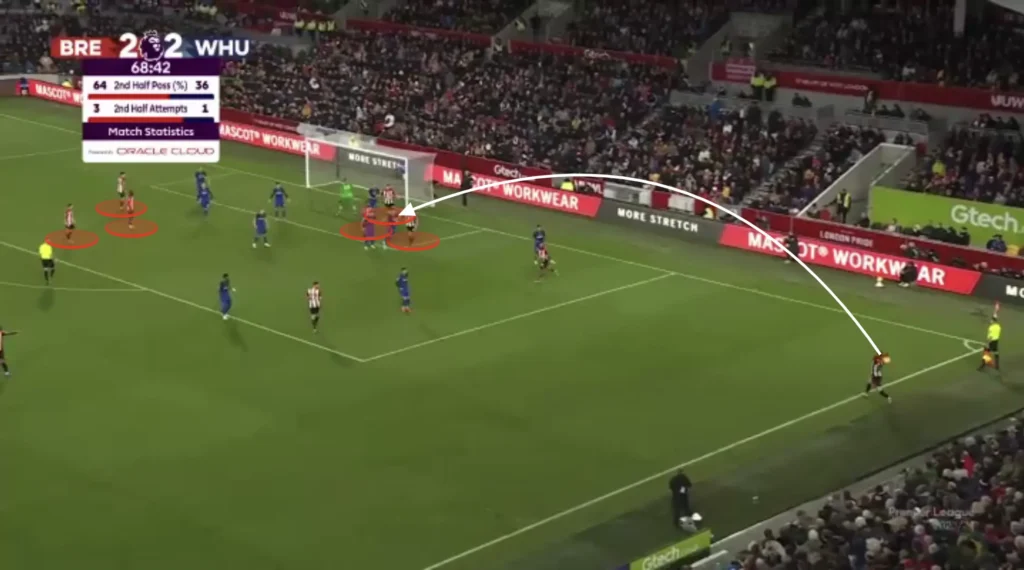
Free-Kicks
They score from many free-kicks, using precise crosses to find teammates in the box. The crosses are usually aimed in the space between the backline and the goalkeeper towards the back post.

Thomas Frank sometimes also wants his team to use crossing free-kicks from their own half. They will push up their entire team, using a long ball from the goalkeeper, trying to get the ball down near the opposition penalty area. Even though they do not look dangerous, Brentford score many goals from these free-kicks, giving them another threat for the opposition to worry about.
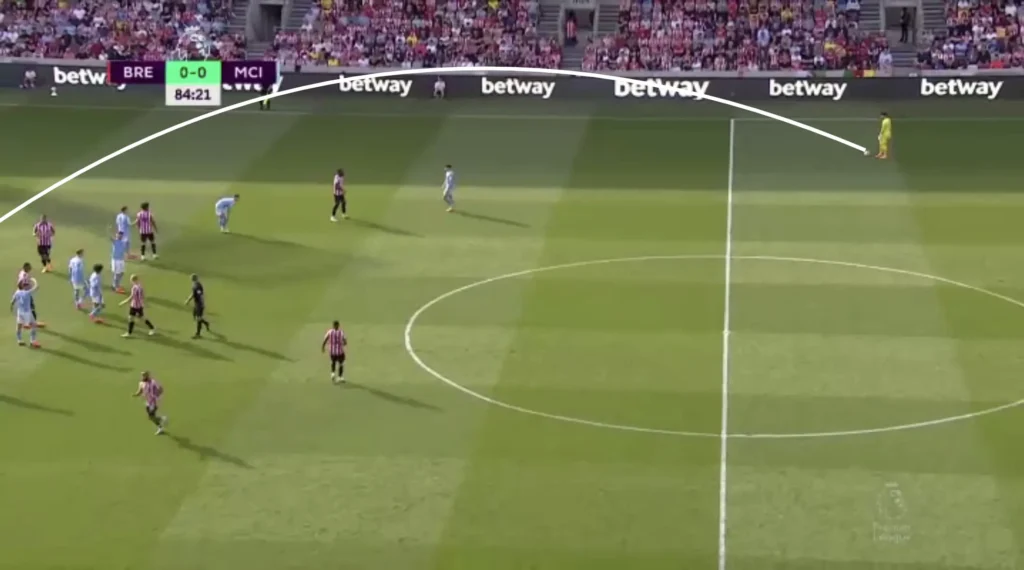
Second-balls
Even if Brentford do not score from the set piece, they will have a lot of players in and around the penalty area to push new crosses into. If they win the second ball, they always look to cross the ball into the box as fast as possible, utilizing the fact that many of their best heading players are still there. This often catches the defending team, who pushes up without looking around, off guard, allowing Brentford to score easy goals.

Defending
Low Press
In the low press, Frank’s Brentford uses a 1-5-3-2 formation. They look to set up in a low-block, always trying to close the center, forcing the opposition out wide. To do this, Brentford are extremely compact in their defensive shape. The compact shape makes it almost impossible for teams to find spaces between the Brentford lines, making them difficult to break down.


Under Thomas Frank’s leadership, Brentford has established a reputation for their relentless work ethic on the field. Frank instills a culture of hard work and determination within his squad, emphasizing the importance of pressing hard, tracking back, and winning second balls. This is crucial for staying compact. The Brentford players will always be very close to each other when defending, especially in their penalty area, often getting the entire team defending the box.

Squeezing the Pitch
Frank’s Brentford also looks to squeeze the pitch when defending. This means constantly pushing the team up as much as possible when defending. Every time the opponent plays a slow, sideways pass or a back pass, Brentford’s first line of pressure pushes up, with the rest of the team following to stay compact. When the next pass comes, they push up even more, forcing the opponent back even more. They do this because it pushes the opponent further away from the Brentford goal, making it harder to create chances. Squeezing the pitch when possible is crucial for teams who do not necessarily look to always be in possession.


High Press
Thomas Frank places much value in being aggressive without the ball. This shows in Brentford’s high pressure. Frank usually wants his team to go man-to-man and intensely press the opposition. They almost use their high press as an attacking threat, scoring many goals from winning the ball high up the pitch.

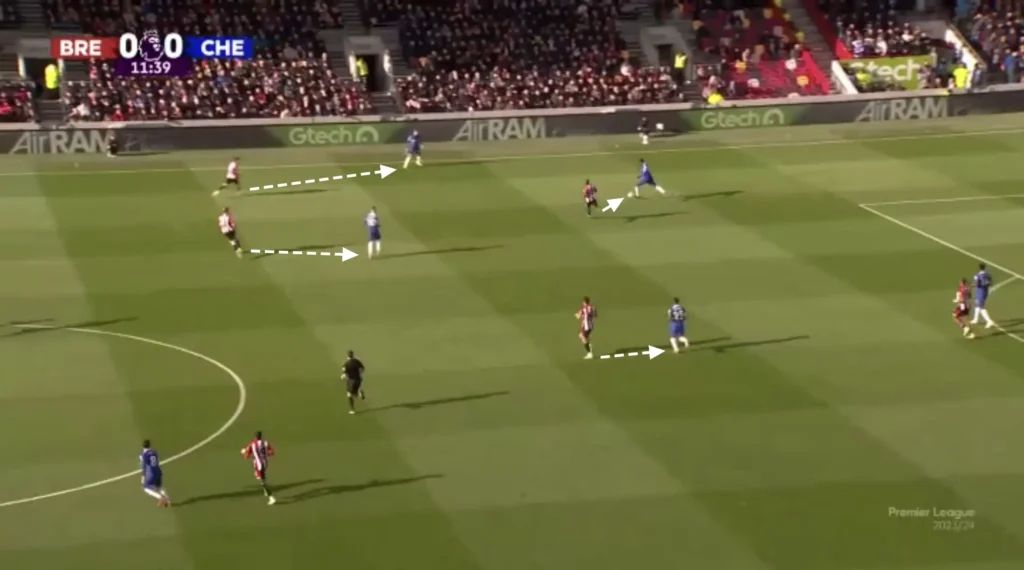
Brentford usually need to rotate in some way when pressing man-to-man because of their normal 1-5-3-2 formation. When playing against a 1-4-3-3, they do this by pushing the wide central midfielders up on the fullbacks and the wide center-backs up to the opposition’s attacking midfielders. Thomas Frank uses this solution because he wants the wingbacks(who are usually faster) to defend against the opposition wingers.

Transitions
Defensive Transitions
Positioning many players centrally, creating a numerical advantage in the midfield, creates good conditions in defensive transitions. Many players close to the ball after losing possession means that many players can work towards regaining possession. Therefore, Brentford often successfully regains possession directly after losing it.

Offensive Transitions
Thomas Frank also wants his team to counterattack in their offensive transitions. They do this with a high tempo, often attacking the spaces between the center-backs and fullbacks. In addition, keeping many players centrally while defending enables them to incorporate more players into the counterattacks.


Final Thoughts
In conclusion, this tactical analysis of Thomas Frank’s Brentford offers a deep dive into the strategic nuances that define the club’s playing style. Frank’s astute tactics and innovative approach have not only transformed Brentford into a competitive force but have also caught the attention of football enthusiasts worldwide. Through meticulous organization, high pressing, and fluid attacking movements, Brentford, under Frank’s guidance, has emerged as a team to be reckoned with in the footballing landscape. As Frank continues to fine-tune his tactical blueprint, Brentford’s journey promises to be one of continued evolution and success on the pitch.
